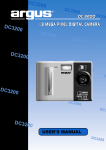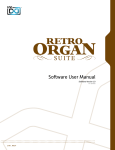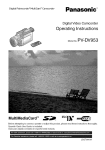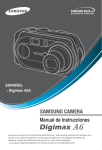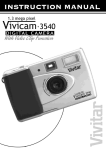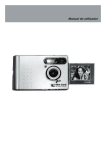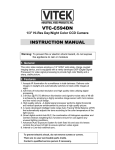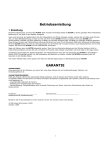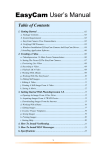Download Vivitar ViviCam 3555T Digital Camera
Transcript
Vivicam 355 CONTENTS Your package.......................................................................................................................................2 Electromagnetic Compatibility Notice.................................................................................................3 Trademarks acknowledgement.................................................................................................4 Precautions..........................................................................................................................................5 Features of the camera..........................................................................................................6 Batteries used for Vivicam 355 Digital Camera...........................................................................7 Input Compact Flash card..................................................................................................8-9 Nomenclature................................................................................................................................10 Buttons Description.........................................................................................................................11 LCD monitor menu.........................................................................................................11-12 Remarks.......................................................................................................................12-14 Status LCD Display....................................................................................................................15 Flash Strobe modes........................................................................................................................15 Playback on LCD monitor.............................................................................................16 Download to computer....................................................................................................16 View photos on TV......................................................................................................................16 CF memory card............................................................................................................17 Connect to TV.................................................................................................................17 Self timer/Digital Zoom / Shot to Shot time/ Rapid fire mode........................................18 Install the Arcsoft Programs and camera drivers in Windows 98/98SE/ME OS..............19-22 Install the Arcsoft Programs and camera drivers in Windows2000/XP OS.....................22-27 Download photos by using PhotoStudio.......................................................................28-29 Use PhotoPrinter Pro....................................................................................................30-31 Use PhotoFantasy......................................................................................................31-33 Use your digital camera as a web camera..............................................................33-34 Open User’s Manual.....................................................................................................34 Uninstall Arcsoft programs................................................................................................34 Troubleshooting................................................................................................................35 Product Specifications.......................................................................................................................36 Software and System Requirements.............................................................................36-37 1 The Vivicam 355 Camera kit includes the following items: Vivicam 355 Camera Software CD ROM USB cable TV (video) cable User's Manual Quick Start Guide Warranty Card Hand Strap Alkaline Batteries (AA) 1 unit 1 piece 1 piece 1 piece 1 piece 1 piece 1 piece 1 piece 4 pieces Default settings When you insert the batteries and power-up the camera for the first time, the camera will have the following (default) settings: Flash strobe: Off Resolution: FULL* LCD monitor: Off Auto Power Off: 1 minute Sound (beeper): Off LCD monitor menu language: English Quick View = Off White Balance =Auto Light Frequency = 60Hz Video: NTSC Slide show timing: 3-second delay LCD Brightness/ EV Compensation = 0 2 Electromagnetic Compatibility Notice This device complies with Part 15 of FCC regulations. Operation is subject to the following two conditions: (1) (2) This device may not cause harmful interference This device must accept any interference received, including interference that may cause undesired operation. Warning: Changes or modifications to this camera not expressly approved by the party responsible for compliance could void the user's authority to operate the equipment. This equipment has been tested and found to comply with the limits for a Class B digital device, pursuant to Part 15 of the FCC rules. These limits are designed to provide reasonable protection against harmful interference in a residential installation. This equipment generates, uses, and can radiate radio frequency energy, and if not installed and used in accordance with the instructions, may cause harmful interference to radio communications. However, there is no guarantee that interference will not occur in a particular installation. If the unit does cause harmful interference to radio or television reception (which can be determined by turning the equipment off and on) the user is encouraged to try to correct the interference by one or more of the following measures: • Re-orient or relocate the receiving antenna. • Increase the separation between the equipment and receiver. • Connect the equipment into an outlet on a circuit different from that to which the receiver is connected. • Consult the dealer or any experienced TV/radio technician for help. • Shielded cables are used with this unit to ensure compliance with the Class B FCC limits. • In the event of high electrostatic discharge, the camera may malfunction. To correct this situation, reset the camera by taking out the batteries. 3 Trademark acknowledgements: Vivicam is a trademark of Vivitar Corporation. The Vivicam TWAIN driver is developed by Conexant Systems, Inc., USA. Microsoft, Windows 98/Me/2000/XP are the registered trademarks of Microsoft Corporation. Pentium is a registered trademark of Intel Corporation. Arcsoft Photolmpression is licensed to Arcsoft, USA. All other product names mentioned herein are trademarks or registered trademarks of their respective owners. 4 Precautions: Thank you for selecting the Vivitar Vivicam 355 digital camera. Please read these instructions carefully for a thorough understanding of your new camera before taking pictures. • • • • • • • • • • • • • • • • • This camera is not water resistant and should not be used outdoors in snow or rain. If accidentally dropped in water, please quickly pour out the water, and dry in sunlight or using an air-blower. Protect your camera from excessive humidity. Excessive humidity may cause moisture to form on the lens and your pictures taken may appear to be blurred. Do not expose the camera to sand or dust. Do not attempt to disassemble the camera yourself. Always take it to an authorized service facility for repair. Remove the batteries if you do not expect to use the camera for 30 days or longer. When storing the camera, wrap it in a piece of clean, soft cloth and place it in a cool, dry, dust-free place. Avoid storage in high temperature conditions or in direct sunlight. The batteries may explode or cause burns if disassembled, recharged, shorted, exposed to high temperature, or disposed of in fire. AA-size alkaline or Ni-MH batteries can be used with this camera. It may damage the camera if you use poor quality batteries. Make sure all four batteries are fresh, unused, and fully charged. Ensure that battery polarities are correct when placing the batteries in the camera. Batteries may feel warm after being used for some time. Take care of the lens. Use a soft lens cloth to clean it. Do not subject the lens, LCD monitor screen, or viewfinder to sharp or hard objects. Condensation is a problem when bringing cold equipment into a warm room. Try to put the camera in a plastic bag so condensation forms on the outside of the bag. If the status LCD or the TFT LCD display is damaged, do not touch it. Battery low detection: When you see the battery icon blinking, you should replace the batteries with new alkaline batteries or fully charged NiMH batteries. If the batteries are low you cannot use the flash strobe and you should refrain from using the LCD monitor in order to take more pictures. Battery life is shorter for low quality alkaline batteries. If you use the LCD monitor and the flash strobe, you should use high quality batteries. High power NiMH rechargeable batteries (1300mAH or higher) are also recommended. 5 Features of the Vivicam 355 camera: 1. 2. 3. 4. 5. 6. 7. 8. 9. 10. 11. 12. 13. 14. 15. 16. 17. 18. 19. 20. 21. 22. 23. 24. 25. High speed image processing with multiple functions High quality images with SXGA (1280 x 1024) resolution Large aperture glass lens (F2.8) Short shot-to-shot time (~3 seconds for Full * mode) Two resolutions: SXGA - 1024 x 1024 and VGA - 640 x 480 Three levels of image of quality at each resolution setting 1.8-inch color LCD monitor (280x220 pixels) Ten function control buttons and 1 mode dial as described in this manual USB port for uploading images to your computer, and PC camera mode Built-in flash strobe (4 modes) Compact Flash memory card (type 1) compatibility (CF card not included) Tripod mounting socket Uses (4) common AA Alkaline batteries Exposure compensation (-1.5 to +1.5 eV) White Balance (Auto and 4 other types) 2X Digital Zoom Quick View feature (to confirm/save the last image, or not) TV video output (PAL or NTSC selectable) Slide show mode - on the LCD monitor or on a TV screen Folder selection (DCF compatibility) Files Protection (Current/All) so images cannot be erased Date/Time setting A choice of seven languages for the LCD monitor menus Auto Power off timing selection (1, 2 or 3 minutes selectable) Ability to erase the current image, or all images Notice: The Vivicam 355 has 1MB of internal memory. 500KB is dedicated to camera functionality (the camera operating program). The remaining 500KB of internal memory is available for image storage. This is adequate about six images when the camera is set to " HALF * " (VGA mode - economy quality). It is strongly recommended that you purchase an optional Compact Flash memory card to use with your camera. 6 Batteries used for the Vivicam 355 Digital Camera • • • • • • Insert four (4) AA alkaline batteries into the battery compartment and close the door. Slide the power switch to the "On" position and hold for at least one second. The camera will turn on and the status LCD (on top of the camera) will display camera data. You cannot power up the camera without the batteries. In the future, if battery power is disrupted, some of the settings will be automatically reset. For example, the date and time will be lost and must be reset. Each time the batteries are removed the date resets to 01/01/00 12:00. As the camera is powered on, the image-LCD monitor is "off" to conserve battery power. Press the "DISP" button to turn on the image LCD if you wish to see a live image, or review stored images. The battery icon will blink if battery power is too low (less than 4V). Replace with new alkaline batteries as soon as possible. Note: when connected to your computer by USB the camera will not use USB power from the PC, and batteries will be required. Slide and lift open the battery compartment cover and insert four (4) AA Alkaline batteries with the correct polarities. Then close the battery compartment cover. 7 Inserting a Compact Flash Card (Optional CF Card - not included in kit): 1. Open the CF cardholder cover and lift the ejector arm 2. Insert the CF card as shown 3. Lock the ejector (flip it down) 4. Close the CF cardholder cover 5. Turn the Mode Dial to "Record" mode 6. Turn on the camera using the CF sliding power switch ce 7. You will see the remaining number of photos (FULL*) that can be taken on the status LCD. 8 Removing a Compact Flash Card: 1. Turn off the camera 2. Open the CF holder door 3. Unlock the ejector (flip up) 4. Push down on the CF ejector to release the card 5. Remove the CF card by grasping with your fingers 6. Return the ejector to the stowed position ce CF 7. Close the CF holder door 9 Nomenclature: Hand Strap Mount LED Flash Strobe View Finder Tripod port Lens View Finder Power Mode Dial CF card door 1.8'' TFT Display LCD monitor control buttons Shutter Status LCD Flash/ Timer/ Resolution 10 TV out USB port Description of the Camera Control Buttons: 1. RES: (Resolution) Change from Full* to Half***, Half**, Half*, Full***, Full**. 2. Timer: Turn on/off self-timer (10 second delay) 3. Flash: Toggle between Auto, Red Eye, On (Fill flash), and Off (no flash) 4. Shutter: Press partially to determine exposure settings. Press fully (to bottom of travel) to take an image 5. POWER: Slide to the right momentarily (1 second) to turn on, or turn off the camera 6. MENU: Display or hide the LCD monitor menu 7. UP: Move up in the menu 8. DOWN: Move down in the menu 9. DISP: (Display) • In Record mode: Turn on or off the LCD monitor. • In Play mode: Toggle between full screen, full screen with image information, and display as 3 x 3 thumbnails 10. ENTER: Confirm the item selection. Digital zoom (in Record mode) Mode Dial (5 selectable modes): Rec (Record mode) For taking pictures Play (Play mode) For reviewing stored images Set (Setup mode) For displaying the Setup menu Erase (Erase mode) For displaying the Erase menu, with a press on the MENU button PC (PC mode) For uploading images, and PC camera mode LCD Monitor Menu: There are five menus shown on the LCD monitor 1. RECORD MENU 2. PLAY MENU 3. SETUP MENU 4. ERASE MENU 5. PC MODE RECORD MENU • • • • • LCD Brightness Quick View White Balance EV Compensate Light Frequency (Turn to REC mode, then press the Menu button) -5 to +5, step 1 ON/OFF Auto, Daylight, Incandescent, Fluorescent1, Fluroescent2 -1.5 to +1.5 eV, step 0.3 eV 50Hz or 60Hz 11 PLAY MENU • LCD Brightness • Video Mode • Slideshow • Folder • Protect Images (Turn to PLAY mode, then press the Menu button) -5 to +5, step 1 NTSC or PAL 1 to 10 second timing Select another folder Protect Current/Unprotect Current, Protect All or Unprotect All SETUP MENU • Date/Time • Language (Turn to SETUP mode) Set date and time Select a camera operating language from your choice of English, French, German, Spanish, Japanese, Portuguese, or Italian Beeper On or Off Format the CF memory card. Erase the internal memory. 1, 2 or 3 minutes selection • Sound • Format Media • Auto Power Off ERASE MENU • Erase Current • Erase All (Turn to ERASE mode, then press the Menu button) PC MODE • Mass Storage • Silent Video (Turn to PC mode, then press the Menu button) Upload images PC camera mode Remarks: LCD Brightness You can adjust the brightness of the LCD monitor to suit the lighting conditions. It is not easy to see your images outdoors in sunlight, so you may wish to increase the image-LCD brightness. For indoor viewing, you can use the default value (0). Quick View If Quick View is set to "On" and the LCD monitor is set to "Off", you will see a brief display of the images you take, for 3 seconds. While the image is being displayed you may elect to delete the image, by pressing the 'ENTER' button before the LCD monitor is turned off. If you do not delete the image, it will be saved to memory. White Balance A digital camera is different from the human eye. Your eyes can see a white subject regardless of the lighting conditions. A digital camera includes internal firmware (a computer program) that is designed to automatically correct your images in order to reproduce a true color image. However, this may fail in some special cases. You may assist your camera to correctly adjust the colors by changing from Auto White Balance to Daylight, Incandescent, Fluorescent1 (Daylight fluorescent lamps) or Fluroescent2 (warm white fluorescent lamps). Note however, that the ability to specify lighting conditions is disabled if you use the flash. Therefore you must to disable the flash if you want a particular effect. 12 EV Compensation If the background of your scene is very bright compared to your subject (eg. Sunny day, snow mountain), the exposure may be too low for the intended subject. You may wish to increase the exposure by increasing the exposure value - eV (from +0.3 to +1.5). Likewise, if the background is too dark compared to the subject (e.g. black wall), you may to decrease the eV (from -0.3 to -1.5) Note: + 1eV = the exposure is doubled. -1eV = the exposure is halved Light Frequency If you use the camera as a web cam, you need to select a light frequency equivalent to your local AC-power frequency. The US and Canada is 60Hz, whereas Europe is 50Hz. Video Mode Select the TV system (either NTSC or PAL) to match your TV system. NTSC is mostly for USA and Japan, whereas PAL is common in Europe. Slideshow You can change the display-interval timing from 1 to 10 second for playing slide shows. The time is preset to 3 seconds. When viewing a slide show you may stop the slide show at any point by pressing the ENTER button. Folders Initially a folder named "100cnxnt" will be created on your CF memory card. Images will be stored in this folder. You may create new folders (using a CF card reader) before using the CF card. This can help you organize your images in a preferred logical structure and order. You may create folder names from "101cnxnt" to "999cnxnt". Place a camera image file in the desired folder. Next, insert the CF card into the camera and turn the power on. The camera will show this new folder when you select the Folder item in the Play Menu. If you turn the Mode Dial to Record mode, all the new images will be saved into this new folder (eg. 101cnxnt). Protect Files (images) This feature is used to protect important images from being inadvertently erased. You may protect the current image, or all images. There is an icon (resembling a lock) in the upper left corner of the image display (when image information is shown - press DISP button). Note however, protected images will still be erased if you format the CF card. You will hear a warning beep if you attempt to erase a protected image. Date/Time You may enter the date (month/day/year) and time (hour/minute). Your images will be stored with date and time when they were taken. Use the Up/Down button to increase/decrease the value. Press ENTER to confirm and go to the next entry. The menu will return to the Setup menu when the minute value is set. 13 Language Any one of seven common languages can be selected for the LCD monitor menus: English, French, German, Spanish, Japanese, Portuguese and Italian. English is preset. Format Media It takes about 2 seconds to format a CF memory card (~1s to erase the internal memory). Make sure you have uploaded your important images to your PC before formatting your CF card. Note: You may select "Yes" or "No" to "Reset Image No.?" when you use the Format Media feature. If you select "Yes", the next image taken after formatting will be numbered 1. If you select "No", the next photo taken after formatting will follow the numbering sequence before the media is formatted. For example, if 3 images were taken before formatting, after choosing "No" to "Reset Image No.?", the next photo taken after formatting will be numbered 4. PC Mode • Mass Storage: Turn the Mode Dial to PC mode. Connect the camera to your PC with the USB cord. Slide the Power switch to the on position to power on the camera. The 'PC' icon will be seen on the status LCD. From the Windows Desktop, click on 'My Computer'. You will see a removable disk icon representing the memory in your camera. All the images stored on your CF memory card (or the 500KB internal memory) can be uploaded to the PC hard drive by copying files from this removable disk. • Silent Video: If you select this item (press Menu, Down, ENTER), the USB camera mode is set. You may now use your camera for video conferencing ( web cam mode). 14 Status LCD display - Icon descriptions 1. Battery icon: 2 Levels of battery power indication 2. 4-digit 7-segment display: • In Record mode - shows the total number of images left • In Play mode - shows the number of the last image (eg. 0008) 3. Flash strobe icon: Flash Off ( ), Flash On ( ), Auto Flash (no icon), 4. Red Eye Reduction: Pre-flash is set to avoid red eye . ( ) 5. Timer: 10-second delay after the Shutter button is triggered. Timer icon ( 6. HALFULL : FULL = SXGA 1280x1024, HALF = VGA 640x480 7. *** : Image quality setting. *** High, ** Normal, * Economy 8. Rapid Fire mode icon: ( ) ) Messages Displayed on the 7-segment display: • BUSY - Image data is being processed to be saved as JPG file to memory • PC - Mode dial is turned to PC mode. Front face LED indication: Off Self-timer is not used Blinking Self-timer has been initiated Flash Strobe Modes: The flash is preset to "Auto Flash" when the batteries are inserted Auto: the flash fires according to the light condition. On: the flash is forced to fire. This is useful for backlit scenes. This is known sa "fillflash" Off: the flash is suppressed and will not fire. This is used for indoor lighting or for taking objects at a distance too far for the flash to have an effect. The camera will utilize its white-balance corrective algorithms to get natural colors Red Eye: this will help to ensure the subject's eyes appear natural (not red) when photographing in low lighting conditions. The flash will fire a pre-flash just before the picture is taken and then fire again to take the actual picture. 15 Playback on LCD monitor • • • • • Turn Mode Dial to "Play" mode , the last image will be displayed. Press the “UP” or “DOWN” buttons to review your images Press the "MENU" button to set the following: - LCD Brightness, Video Mode, Slide Show, Folder, Protect Files - Video Mode (select NTSC/PAL TV system) - Slide Show time interval (from 1 to 10 seconds) - Folder (select the folder you want to review) - Protect files (to protect the images from being erased) Press “DISP” once to display image information Press “DISP” twice to display 9 image thumbnails together Downloading Images to your Computer * Make sure you have installed the camera driver and taken some images. For details of driver installation, please refer to the camera driver installation section of this Manual. 1. Turn on the camera 2. Turn the mode dial to “PC” mode 3. Connect the camera to your computer using the USB cable 4. Open Windows Explorer 5. 6. 7. 8. Look for the “Removable Disk” folder Expand this icon until you see the folder “100cnxnt” under “Dcim”. Click on “100cnxnt” folder and you will see your image files Copy them to your hard drive or other storage location Viewing your images on a TV 1.Connect the camera to the TV with the provided TV cable 2.Power on the camera 3.Turn the Mode Dial to "Play" mode 4.The last image file is shown on the TV screen 5.Press the “UP” or “DOWN” button to view other images 16 CF memory Card Storage: If you have an optional CF memory card, you may store images as shown in the following table: 16MB 32MB 64MB Resolution & Quality Full *** 15 30 Full ** 30 60 Full * or Half *** 60 120 Half ** 120 240 Half * 240 480 FULL = SXGA 1280x1024, HALF = VGA 640x480. Quality: ***(High), ** (Normal), * (Economy) 60 120 240 480 960 Note: The above table is the approximate number of images that may be stored. The actual number of images you can store varies according to the image environment (visual complexity). • • • • • • Only CF type 1 memory cards are suitable for the Vivicam 355 camera. Using quality CF memory cards e.g. San Disk, Lexar, Kodak is recommended. Compatibility with other poor quality CF memory cards is NOT guaranteed. If you insert the CF card while the camera is powered on, you must power off and on again to get the frame number estimation to match the CF card memory size Do not change the directory (folder) names or file names from your PC. If you do so, the camera may not open the image files Images are stored in the folder Dcim\100Cnxnt on the CF card. You may save the images to PC directly by using a CF card reader If you copy image files from other sources to your CF card, they cannot be viewed by the camera Connecting to a TV When connected to a TV you can view all features normally presented on the image LCD • Connect the TV cable as shown. You can see live video if the camera is set to "Record" mode • You can review images if the camera is set to "Play" mode. This is ideal for reviewing images with a group of people in front of a large TV screen. 17 Self-Timer Press the Timer button to turn on the self-timer. The self-timer icon is shown on the status LCD display. Press the shutter fully down to trigger the self-timer. You will hear beep after the 7th second. The camera will take an image after the 10th second. The front LED will blink during the 10-second period. Digital Zoom In “Record Mode”, press the “DISP” button to turn on the image display and press “ENTER” button to use the 2X Zoom mode. “2 x D Zoom” will be displayed in the bottom left-hand corner of the display. The central portion of the image is enlarged (zoomed) by a factor of two. Press the Shutter button to take an image. Press the “ENTER” button again or switch off the power, and the 2 X Zoom function will be cancelled. Note: When the 2 X Zoom is activated, the image resolution will automatically be set to VGA, i.e. HALF*. This simulates the effect of using a 2X zoom lens. It is best to review the images on image display. Image on TV/TFT Digital Zoom Image on TV/TFT Shot-to-Shot time This is the processing time for the camera before it is ready for next shot. The following table presents shot-to-shot time for resolution and quality combinations. Quality mode FULL *** FULL ** FULL * / HALF *** HALF ** / HALF * Processing time ~6 seconds ~4 seconds ~3 seconds ~2 seconds Rapid-Fire (Burst) Mode In the Record mode, press the "RES" button until the icon " " is displayed. By pressing and holding the shutter button, you may take continuous images. The camera will continue to take images until the available memory is used up. Because of the time required to re-charge the strobe after each photo, it is recommended that the strobe flash be de-activated when using the rapid-fire mode. Half Full : VGA 640 X 480 : SXGA 1280 X 1024 18 Install Arcsoft programs and camera drivers in Windows 98/98SE/Me OS Note: The graphics shown are based on the user interface in Windows 98SE 1. Put the CD-ROM into your CD-ROM drive. It will automatically start and run 2. Select your desired language and click OK button 3. Click Next button 4. Click Yes button to accept the license agreement 5. Change the Destination Folder by clicking the Browse button if necessary and click the Next button 19 6. Select the Arcsoft programs you wish to install and click Next button 7. Change the name of the program folder if necessary and click Next button 8. Files will be copied to your computer 9. Click Finish button to install camera drivers 20 Install Camera drivers 10. Click Next button to start the camera driver installation 11. When installation is complete, click Finish button to restart your computer 12. After the computer is restarted, power up your camera 13. Switch the Mode dial to PC mode 14. Connect the camera and computer with the USB cord 15. "Removable Disk" will automatically be installed in your computer. Several screens will appear momentarily. 16. When the "Removable Disk" installation is complete, press the MENU, DOWN, ENTER buttons on the camera to select Silent Video mode 17. Video driver will be installed in your computer 18. The camera driver installation is complete. Note: In rare occasions, the camera driver may possibly conflict other USB devices in your computer system. Check your image files 1. Make sure the camera is connected to your computer and is in Mass Storage mode. Press MENU, UP, ENTER buttons on the camera if necessary. 2. Open Windows Explorer 3. Search through Removable disk>Dcim>100cnxnt and double-click on the 100cnxnt folder 4. The image files are shown in the right pane 21 Check the video driver 1. Press MENU, DOWN, ENTER buttons on the camera to select Silent Video mode 2. Search through Start>Settings>Control Panel>System>Device Manager>Imaging Devices>Vivicam 355 Video Camera Install Arcsoft programs and camera drivers in Windows 2000/XP OS Note: The graphics shown are based on the user interface in Windows XP 1. Put the program CD-ROM into the CD-ROM drive, it will run automatically 2. Select your desired language and click OK button 3. Click Next button 22 4. Click Yes button to accept the license agreement 5. Change the Destination Folder by clicking Browse button if necessary and click Next button 6. Select the Arcsoft programs you wish to install and click Next button 7. Change the name of the program folder if necessary and click Next button 23 8. Files are being copied to your computer 9. Click Finish button to install camera drivers Install camera drivers 10. Click Next button to start camera driver installation 11. Click Continue Anyway button (for Win XP) or Yes button (for Win 2000) when you see the warning message 24 12. When Setup is complete, click Finish button to restart your computer 13. After your computer is restarted, power up your camera 14. Switch the Mode dial to PC mode 15. Connect the camera and computer with the USB cord 16. The following screen will appear to signal the Removable Disk has been installed in your computer. Click Cancel button to move on to video driver installation. 17. Press MENU, DOWN, ENTER buttons on the camera to select Silent Video mode and wait for the following screen to appear. Select as on the screen and click Next button to start the video driver installation. 25 18. Click Continue Anyway button (for Win XP) or Yes button (Win 2000) when you see the warning message 19. Click the Finish button 20. Drivers installation is complete Note: In rare occasions, the camera driver may possibly conflict other USB devices in your computer system. Check your image files 1. Make sure the camera is connected to your computer and is in Mass Storage mode. Press MENU, UP, ENTER buttons on the camera if necessary. 2. Open Windows Explorer 26 3. Search through Removable disk>Dcim>100cnxnt and double-click on 100cnxnt folder 4. The image files are shown on the right pane Check the video driver 1. Press MENU, DOWN, ENTER buttons on the camera to select Silent Video mode 2. Search through Start>Control Panel>System>Hardware>Device Manager>Imaging devices>Vivicam 355 Video Camera 27 Download images using Photo Studio NOTE: The graphics shown are based on the user interface in Windows 98SE 1. Search through Start>Programs (“All Programs” for Windows XP) >Vivicam 355 Digital Camera Suite and click PhotoStudio 2000 icon OR double-click the shortcut created on your computer desktop 2. Search through File and click Select Source icon from the pull-down menu 3. Highlight Vivicam 355 Digital Camera and click Select button. Make sure your camera is in Mass Storage mode and connected to your computer. 4. Search through File and click Acquire icon 28 5. Click Disk Folder icon at the bottom to view/change the folder to which the images will be copied. Default folder is C:\WINDOWS\Desktop\My Photos. 6. Highlight the images you want to save (or click Select All icon to highlight all photos) and click Save icon. 7. To retrieve the saved images, click File>Open. From the Open dialog box, look in your preset folder, highlight the image file and click Open button. 29 Use PhotoPrinter Pro NOTE: The graphics shown are based on the user interface in Windows 98SE. 1. Search through Start>Programs (“All Programs” for Windows XP) >Vivicam 355 Digital Camera Suite and click PhotoPrinter 2000 Pro icon OR double-click the shortcut created on your computer desktop 2. Click get photo icon 3. Click “Down” arrow on the upper left corner and select New from the pull-down menu. 4. Click add photo icon. Look in your preset folder, highlight the image file and click Open button. 30 NOTE: You can also download photos from your digital camera by clicking the acquire photo icon. Please go to “Download Photos by using PhotoStudio” section for similar procedures. 5. Highlight the photos and click okay button 6. You may now set your print options. Use PhotoFantasy NOTE: The graphics shown are based on the user interface in Windows 98SE. 1. Search through Start>Programs (“All Programs” for Windows XP) >Vivicam 355 Digital Camera Suite and click PhotoFantasy 2000 icon OR double-click the shortcut created on your computer desktop 31 2. Click Get Fantasy icon. You need to put the program CD-ROM to the CD-ROM drive to view the sample photos. 3. Select the template you want and click Okay icon 4. Click get photo icon and then click Add icon at the bottom NOTE: You can also download photos from your digital camera by clicking on the acquire photo icon. Please go to “Download Photos by using PhotoStudio” section for similar procedures 32 5. From Open dialog box, look in your preset folder; highlight the image file and click Open button. 6. Click Okay icon 7. You can modify the image as desired Use your digital camera as a web camera 1. Start Windows Net Meeting (or other similar program) and set up an account. 33 2. Power up your camera and connect it to the computer. Press MENU, DOWN, ENTER buttons to select Silent Video mode. 3. Click Start Video icon and you should see a live picture. 4. Click Stop Video icon (same as the Start Video icon) to end. Open User’s Manual 1. Search through Start>Programs (“All Programs” for Windows XP) >Vivicam 355 Digital Camera Suite > User Manual Uninstall Arcsoft programs 1. Search through Start>Programs (“All Programs” for Windows XP) > Vivicam 355 Digital Camera Suite > Uninstall 34 Troubleshooting: If you experience difficulty with your camera, check the following 1. No Power 2. No Image is taken 3. Flash does not operate 4. Images are too dark with flash 5. Image is blurred 6. Can't erase an image 7. LCD monitor is off 8. No display on the status LCD 9. Card Full is displayed 10. The object is too dark 11. The object is unclear 12. Images are too yellow 13. Camera does not recognize my CF card 14. I cannot use the video camera mode 15. I am using “Easy-CD Creator (version 4.X or below) and I have problem installing the camera driver, what should I do? The batteries are depleted, or battery polarities are inverted (backwards) Internal memory, or CF card, is full Camera set to Flash Off mode. Battery power is low. The subject is too far away. Flash was obscured. The lens is dirty or has condensation It is protected. Unprotect it. The Mode Dial is set incorrectly The camera has auto-powered off No CF card is inserted, or the card is full Change the position to avoid backlit problem. Use eV compensation. Try 1eV or 1.5eV Environment is too dark. Use flash or tripod. Change the White Balance to other settings Power the camera off and on. Verify that the CF card is fully inserted Make sure you have selected 'silent video' mode • Vivicam 355 Digital Camera’s installation CD includes an “auto-check” program to detect if your PC has any software conflicts between other devices and the camera. If the “auto-checker” detects existence of software conflicts, it will recommend and guide the user to download updated drivers from appropriate website to solve the conflict problem. • If you cannot download the driver try the following procedures: 1. Insert the Vivicam 355 Digital Camera installation CD into the CD-ROM drive 2. Look for the file “recover.bat” stored on the CD 3. Double-click the file to initiate the recovering process 4. Restart your computer 5. Install the camera driver again 35 PRODUCT SPECIFICATIONS 1. 2. 3. 4. 5. 6. 7. Resolution Image Quality Lens Number of Images (Built-in memory) 1.8-inch LCD monitor LCD monitor Menu Special Features 8. 9. 10. 11. 12. 13. 14. 15. Others Buttons and Switch Strobe Flash Battery Power Auto-Off Self timer TV video out White Balance 16. 17. 18. 19. 20. 21. 22. 23. 24. Digital Zoom File format Focusing range EV Compensation Low Battery Detection Battery Life(Alkaline) Operating conditions Dimensions Net Weight Software : 1. Camera Driver 2. Photo Impression FULL : 1280 x 1024 (SXGA), HALF : 640 x 480 (VGA) *** FINE, ** NORMAL, * ECONOMY Glass, 5 elements, F/2.8, 35mm(Equiv) FULL * : 1 HALF* : about 6 280x220 dots, True color TFT display. Seven languages (European and Japanese) Quick View, Slide show, Folder selection, Image File Protection, Date/Time adjust, Auto power-off time, Erase Current/All View Finder, Status LCD, Buzzer, LED, Tripod mount Ten control buttons and one rotary Mode Dial. Four modes : Auto, On, Off, Red-Eye. Alkaline AA battery x 4 ( 6V) 1, 2 or 3 minutes selectable 10 seconds delay NTSC or PAL selectable Auto,Daylight,Incandescent, Fluorescent1 or Fluroescent2. 2X digital zoom. (HALF *) JPEG (DCF compatible) 1meter to infinity (fixed-focus lens) From -1.5 to +1.5 EV , step 0.3 EV Two levels. Approx. 1 hour with LCD monitor on. 0 ~ 40 degree Celcius. 80 x 110 x 35 mm (HWD) 190g w/o battery USB Storage-class-Removable Disk Print images in simple steps Photo editing program Link to walmart.com Specifications are subject to change without notice. 36 System Requirements: 1. Pentium 300MHz or above. 2. Operating Systems: PC Win98/ 98SE/ 2000/Me/XP* 3. 32MB SDRAM minimum for Win98/98SE 64MB SDRAM for WinMe/Win2000 128MB for WinXP. 4. Minimum 300MB hard disk free capacity, 1GB for WinXP. 5. With USB port and CD-ROM drive. * Camera driver installation on Windows XP is done at users’ own risks. We accept no responsibility for any damage caused to users’ computer systems or any other related equipment. 37 Rev. 020310








































